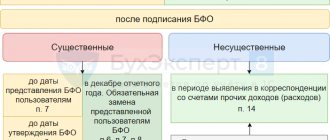What is revenue from product sales?
Revenue from product sales represents cash income received by an organization from customers for products sold.
The indicator expresses the monetary relations between producers and consumers of goods. Revenue from sales of products is determined based on the quantity of products sold and their cost. For tax purposes, it is recognized as income from sales. Revenue is not profit; a separate line is allocated for it in the “Income Statement”. The head of the organization must ensure the uninterrupted flow of revenue, since without this the business simply will not be able to function.
The following factors influence the amount of revenue from product sales:
- internal (production volume, range of manufactured goods, their quality and competitiveness, level of prices applied, cost, compliance with contractual terms, etc.);
- external (violation of contract terms, interruptions in transport, etc.).
Calculation of revenue using the formula
Let's look at how to find revenue from sales of products using the formula. When making calculations, it is necessary to take into account the current sales volume and prices. The general formula for revenue from product sales looks like this:
Q – number of goods sold;
P – selling price.
The formula can be used to evaluate an organization's performance and build long-term plans.
In practice, accounting for revenue from the sale of products, works and services is carried out using two methods:
- cash method (if the moment of sale is recognized as the fact of receipt of money to the seller’s bank account);
- accrual method (if the moment of recognition of income is the fact of shipment of goods).
Example 1
LLC "Electrod" is engaged in the production of lamps. During the reporting year the following products were sold:
- lamp “Ella” – 700 pieces at a price of 250 rubles;
- lamp “Teresa” – 600 pieces at a price of 340 rubles;
- lamp “Miranda” – 400 pieces at a price of 600 rubles.
The annual revenue will be calculated as follows:
B = (700 × 250) + (600 × 340) + (400 × 600) = 619 thousand rubles.
Example 2
IP Petrov A.A. applies the cash method of accounting for income and expenses. On January 25, 2021, the entrepreneur delivered goods to the buyer for a total amount of 180 thousand rubles. On March 5, 2021, the individual entrepreneur agreed with the buyer on a mutual settlement in the amount of 106.2 thousand rubles. (including VAT – 16.2 thousand rubles). What revenue should an entrepreneur report?
As of the date of the offset agreement with the buyer (March 5, 2021), the individual entrepreneur is obliged to take into account income in the amount of the repaid debt (excluding VAT): 106,200 – 16,200 = 90,000 rubles.
Example 3
On February 12, 2021, Teplomash LLC shipped goods worth 600 thousand rubles to Ryabina LLC. Ryabina LLC paid off with Teplomash LLC on April 3, 2021, transferring money to its bank account. Teplomash LLC uses the accrual method when accounting for income, so all revenue will be displayed in accounting and tax accounting in February.
Reflection in accounting
Account 90 “Sales” is used to record revenue from sales of products. The account consists of several sub-accounts. Postings for revenue from sales of products are compiled in order to determine the financial result from sales. The mandatory conditions under which revenue is recognized in accounting are given in PBU 9/99.
Revenue functions
The main function of revenue is to compensate for expenses, funds that were spent on the purchase of goods or their production. Financial resources received from the activities of the enterprise are transferred to accounts. Timely translations are ensured by:
- stability of the company's activities;
- continuity of turnover of goods.
Typically, proceeds are spent on the following purposes:
- payment for services of suppliers;
- acquisition of products or materials for their production;
- payment of salaries to employees;
- payment of taxes;
- expansion of the enterprise.
That is, funds are usually invested in developing the business and maintaining its viability.
Delayed revenue receipts lead to negative effects:
- enterprise losses;
- decrease in profit indicators;
- payment of fines accrued for failure to meet deadlines for loan payments;
- violation of contractual obligations to business partners;
- inability to pay all bills.
The head of the organization must ensure uninterrupted receipt of revenue. Without regular and timely receipt of funds, a business cannot exist.
Analysis
Analysis of revenue from product sales allows you to solve the following problems:
- determine the validity of the business plan indicator for the sale of goods;
- determine the degree of plan fulfillment in terms of the volume and range of products sold;
- establish the influence of individual factors on the deviation of actual sales volume from the planned one;
- identify reserves for further increase in sales.
One of the effective methods of economic analysis is factor analysis of revenue from product sales. It helps to determine the influence of specific factors on changes in revenue. In the process of analysis, much attention is paid to the following factors: volume of sales of goods, selling prices, cost, structure of products sold.
Planning
The head of the organization or special services can plan revenue from the sale of products, works, and services. In an unstable economic situation, quarterly planning will be more effective than annual planning.
To plan revenue from product sales, the following methods are used:
- Direct counting method. Applicable in case of guaranteed demand. Products are produced in the quantities specified in pre-orders. Revenue is calculated by multiplying the volume of products sold by its price.
- Calculation method. It is used in conditions of uncertainty of demand for manufactured goods. The prospects for their implementation are taken into account.
Reflection in accounting
In accounting, revenue is recognized when the following legal and economic conditions are met:
- To receive revenue legally, an organization or enterprise must have the right to do so, which is provided for in a specific agreement.
- The amount of revenue can be determined.
- There is confidence that as a result of the transaction with a product or service, this will be followed by an increase in economic benefits.
- The service was provided in a timely manner.
- The costs of transacting a product or service can be determined.
If at least one of the above conditions is not met, not revenue will be recognized in accounting, but accounts payable.
Why determine sales revenue during business planning?
Revenue , its analysis and planning are crucial for the functioning of the enterprise. This is due to many factors, we list some of them:
- Revenue is a determining factor in the effectiveness and efficiency of an enterprise;
- The size of revenue and volumes of products sold determine the feasibility of launching a particular project;
- The timely receipt of revenue determines the financial stability of the company, the state of its working capital, profit margins and timely payment of obligations (payment of wages to employees, settlements with banks on loans, with suppliers for work and services, etc.).
- Revenue is the basis for the break-even of an enterprise, since it is the receipt of revenue that allows the company to cover the costs of production and sales of products.
- From the above, another important meaning of revenue is the source for generating profit.
Recognition Criteria
The general approach to properly reporting revenue is to account for the transfer of goods and services to the customer for the amount that the customer is expected to pay in exchange for goods shipped or services rendered.
However, depending on financial reporting standards, revenue recognition criteria may differ.
In other words, the same transaction may be reflected in financial statements prepared under different standards in radically different amounts.
The general criteria for revenue recognition are:
- high probability that the company will receive economic benefits associated with the transaction;
- the ability to reliably evaluate remuneration;
- the ability to reliably estimate the costs incurred and/or expected to complete the transaction.
Production costs
Considering the costs for the entire volume of output, the following production costs :
— constant (FC) - costs that do not depend on the volume of output (Q) and arise even when production has not yet begun. Thus, even before production begins, the enterprise should have at its disposal such factors as buildings, machines, and equipment. In the short term, fixed costs are rent, security costs, property taxes, etc.;
— variable (VC) - costs that change depending on the volume of output. These include: basic and auxiliary materials, workers' wages, transportation costs, electricity costs for production purposes, etc.;
— total (TC) – the sum of fixed and variable costs:
TC = FC + VC
Variable and total production costs increase along with an increase in output, but the growth rate of these costs is not the same. Starting from scratch, as production increases, they initially grow very quickly, then as production volumes continue to increase, their growth rate slows down and they grow slower than production (positive economies of scale). Subsequently, however, when the law of diminishing returns comes into play, variable and total costs begin to outpace production growth.
Average monthly revenue
As part of the financial analysis of an enterprise's activities, third-party and internal analysts calculate various types of revenue. The goals of such analysis and division into types may vary depending on the activities of the enterprise or the preferences of the enterprise management. One example of an analytical calculation is the calculation of average monthly revenue.
where Save is the average monthly sales,
Sn – revenue for the nth number of months,
n – number of months.
Economic costs
Economic costs include both external and internal (including normal profit) costs, while accounting costs include only external ones.
Since the amount of accounting and economic production costs does not coincide, there are also differences in the amount of accounting and economic profit.
Net economic profit is equal to sales revenue minus the economic costs of production (external and internal, including normal profit).
The ability to change production methods and costs varies depending on how long it takes a firm to change production technology or respond to changes in market conditions. This fact is reflected in the existence of differences between production costs in the short and long term.
The short-run period is a period when most of the factors of production remain constant, fixed, and in order to increase (or reduce) the volume of production the firm can change only one factor of production. In the short term, such types of costs as buildings, equipment, and crop areas remain constant, so the company can influence production volume by changing only, for example, the number of employees hired.
Average sales revenue growth rate
Revenue is a key indicator of the performance of a commercial enterprise. Reliable accounting and detailed and constant analysis of this indicator is the main source of information for making management decisions.
Therefore, in practice, the company calculates revenue in various sections. As part of financial analysis, it is advisable to calculate income growth rates by product or product group.
In this case, the organization’s management has the opportunity to more effectively assess growth points and respond to possible threats.
How is it reflected in the balance sheet?
Next in order of decrease are marginal (minus variable costs), gross (minus technological cost), sales (minus full cost), operating (minus other expenses with the addition of other income and interest payable), balance sheet (minus other expenses with the addition of other income), net (less taxes). How to calculate the profit of an enterprise All types of profit are calculated on the basis of revenue, which is equal to the product of sales volume and unit price.
Certain cost items are subtracted from primary income and thus each type of profit is found. General calculation formulas Revenue is calculated using the following formula: TR = P * Q, where TR (total revenue) – revenue, rub.; P (price) – price, rub.; Q (quantity) – quantity of products, rub.
Revenue indicator in accounting (financial) statements
Let's talk about the balance sheet. For small businesses, it consists of Form No. 1 “Balance Sheet” and Form No. 2 “Profit and Loss Statement.”
The balance sheet contains indicators of the enterprise’s property – “Asset” and sources of formation of property – “Liability”. The balance sheet shows the summary (balance) as of the reporting date. Form 2 describes the movement (turnover) during this period.
When registering an enterprise, in addition to the main type of activity (according to OKVED), you indicated other, additional types.
Then your revenue will be collected from:
- Revenue from the main activity;
- Proceeds from investments;
- Revenues from financial activities.
And in the accounting (financial) statements (including form 2), revenue from the main type of activity and other income (income from other, additional types of commercial activities) will be taken into account separately.
Example. A retail chain company leased a temporarily empty store premises and provided a cash loan to its employee. The main type of activity in this example will be retail trade (revenue from the sale of goods will go to revenue column f.2). Payment for the rental of premises and interest under the loan agreement will be revenue from additional types of activities (in accounting and Form No. 2 - this will be additional income).
Finally, let’s go through Form 2 to understand the relationship between the revenue indicator and other financial parameters:
- Sales revenue (net) - cost of goods sold = gross profit;
- Gross profit - selling expenses = profit (loss) from sales;
- Profit from sales -(+) operating and non-operating expenses (income) = profit (loss) before tax;
- Profit before tax - income tax (if you are on the main tax system) = profit (loss) from ordinary activities;
- Profit from ordinary activities - (+) extraordinary expenses (income) = retained earnings (uncovered loss).
So, now we understand for sure that equating the concepts of revenue, income and profit is completely wrong. However, revenue has a significant impact on these two metrics.
Value of revenue from product sales
The revenue of an enterprise plays a big role in the functioning of the enterprise. The revenue value is determined as follows:
- Determines the effectiveness and efficiency of the enterprise,
- The timely receipt of revenue determines the financial stability of the company, the state of its working capital, profit margins and timely payment of obligations (payment of wages to employees, settlements with banks on loans, with suppliers for work and services, etc.),
- With revenue, the enterprise covers its costs of production and sales of products, generating profit.
Differences between revenue, income and profit
Let's summarize all the differences in a table. We will not take into account turnover, since in most cases it coincides with revenue.
| Income | Revenue | Profit |
| increases the economic benefit (benefit, profit) of the company | characterizes the amount of money received for payment for goods, works, services | is the final result of the company's activities |
| expressed in money or property form | has a monetary value | expressed in absolute amount |
| applies to legal entities (company income) and individuals (pension, scholarship, etc.) | is the main source of formation of the company’s own financial resources | takes into account company expenses |
| can take a negative value | cannot be negative | may be negative, means loss |
Table 1. Main differences between income, revenue and profit.
Let's consolidate the theory with an example: it provides design, cutting and sewing services for curtains. Revenue from the development of design projects, sewing custom-made curtains and selling ready-made sets for the month was received in the amount of 450 thousand rubles.
Normal profit
Normal profit represents the minimum fee with which entrepreneurial ability must be rewarded in order to stimulate its use in a given firm, i.e. this is the minimum income that an entrepreneur must receive in order to remain in this business. This income should be no less than the profit that the entrepreneur could have in another, most profitable field of activity for himself, but is “lost” by him. Almost normal profit is determined by the entrepreneur himself as an assessment of alternative opportunities for applying his entrepreneurship.
Types of revenue
Proceeds from the sale of goods (services) consist of funds or other property in monetary terms that are received or are to be received from the sale of goods (products, services, works) at prices and tariffs in accordance with the concluded agreement.
The activity of the enterprise is characterized in several areas:
- The main activity from which revenue comes from the sale of products (performance of work, provision of services);
- Investment activity, the proceeds from which are expressed in the form of a financial result from the sale of securities or the sale of non-current assets;
- Financial activities (revenue).
Total revenue can be determined by summing the revenue from these three areas. But, nevertheless, the main significance in it is revenue from core activities, which determines the entire meaning of the existence of enterprises.
How to Calculate Gross Sales Revenue
The gross revenue of an enterprise is the entire amount received into the organization's budget from activities without expenses.
Namely:
a) the amount from the main activity; b) from investments and transactions of the enterprise;
c) from other financial activities
By summing up the entire amount of money received as a result of activities and not taking into account expenses, we get gross revenue. The main activity of the company is sales.
Therefore, item a) will be considered gross sales.
What is the difference between revenue and income
The relationship between revenue and income is in many ways similar to the profit example discussed above. Let us note once again that the amount of revenue does not mean that the amount of income will be similar. Thus, income is a more “purified” concept.
Let's look at this with an example.
You produced 100 units of products and then sold them at a price of 50 rubles per unit. Then the revenue amounted to 5,000 rubles. But this does not mean that the income is the same amount.
Firstly, the unit cost of production was 15 rubles per unit. And for the entire sales volume this is 15 x 100 = 1500 rubles.
Secondly, during the sale of products the following types of expenses were also incurred (in total):
- Management costs = 150 rubles;
- Commercial expenses = 350 rubles.
Thus, we subtract the above-mentioned areas of costs from Revenue and find that the profit is:
Profit = Revenue - Cost - Selling expenses - Administrative expenses = 5000 - 1500 - 150 - 350 = 3000 rubles.
But, again, a profit of 3,000 rubles does not mean that the profitability of the enterprise was 3,000 rubles. For example, an entrepreneur also had temporarily free funds and decided to invest them in another project on the condition of receiving a percentage of the profit from this project. During the investment, he received interest income in the amount of 1000 rubles.
Then the total income of the enterprise from commercial and investment activities amounted to 4,000 rubles (profit + interest income). Thus, income is a concept interrelated with revenue , and to some extent more “narrow”. But more “broad” than profit. Although in many cases these values are identical.
In general, the total income of an enterprise in accordance with international financial reporting standards is formed from three areas of activity:
- Commercial;
- Financial;
- Investment.
Why calculate revenue?
Revenue is one of the main indicators of a company’s performance, so the importance of its calculation cannot be overestimated. When determining revenue, an entrepreneur can pursue the following goals:
- Monitoring consumer demand for goods or services. Such an event will help to assess which products are more in demand and in demand, due to this it is possible to adjust the company’s assortment and pricing policy.
- Analysis of revenue over time. Comparing the volume of products sold and the money received for it over time allows you to create a strategy for further sales or production, and draw up a plan for purchasing activities.
- Finding the financial stability of the company, determining the state of working capital, ensuring timely settlements with counterparties, for example, with payroll employees, with credit institutions, with suppliers, etc.
- Determining the profitability of an enterprise, an individual project or production. Revenue is directly related to finding profitability. When calculating profitability ratios, formulas are used that use the amount of revenue. Based on the data obtained, conclusions are drawn about the effectiveness of the business.
Revenue indicators in the company's financial statements allow management to assess the potential for further development and develop a strategic action plan. In addition, this information may be required by business partners, investors, regulatory authorities and creditors.
Summarizing
Thus, we hope that the justification given has become good evidence that the income of an enterprise is a vital component of both the organization of the activities of a new enterprise and the development of an existing one. At the same time, income is not limited only to the concept of “Revenue” and includes various components that reveal profitability levels from different sides. And each of the presented levels is an important element of the financial and economic analysis of the company.
Often, during the preparation of a business plan, many entrepreneurs have a number of questions related to planning the project’s income and integrating this section into the overall content of the document. Therefore, we advise you to focus on a ready-made sample business plan for an enterprise similar to yours. Or you can turn to professionals who can draw up a full-fledged business plan for your project, taking into account all its features.
Sources
- https://PravoDeneg.net/buhuchet/vyruchka-ot-prodazh-formula.html
- https://plan-pro.ru/entsiklopediya-biznes-planirovaniya/finansovoe-planirovanie/vyruchka-formula-rascheta-otlichiya-ot-pribyli
- https://kakzarabativat.ru/nachinayushhim-predprinimatelyam/vyruchka-ot-prodazh/
- https://schetuchet.ru/vyruchka-i-pribyl-predpriyatiya/
- https://abcdwork.ru/finansy/chto-takoe-vyruchka-ot-realizacii-produkcii-planirovanie-vyruchki-otrazheniya-v-buxgalterskom-uchete-faktory-izmeneniya-ekonomicheskaya-sushhnost-pribyli-i-eyo-vidy- osobennosti-podschyota.html
- https://101million.com/buhuchet/prochie-raschety/vyruchka
Calculation of the formula for return on sales
Return on sales is usually calculated by dividing operating profit by sales volume. Operating profit is that profit expressed before taxes. This type of profitability ratio shows whether the company's pricing policy is correct.
After all, it is necessary to have control over costs and expenses. This ratio is often used when assessing the operating efficiency of a company, but is not always applicable for comparing two competitive organizations.
Accounting and economic profit: calculation formulas
Accounting profit is determined for the required reporting period as the difference between the total income and expenses of the enterprise in all areas of activity. Economic profit is also calculated using the formula “Revenue minus Expenses,” but the deductible expenses additionally include the implicit hidden costs of the business.
To determine accounting profit, you need to calculate the difference between revenues and external costs.
Accounting profit = Revenue (income) – External costs (accounting expenses)
To determine economic profit, you need to calculate the difference between accounting profit and internal costs.
Economic profit = Accounting profit – Internal costs (opportunity costs)
What is gross revenue from product sales
So, revenue from the sale of products (goods and services) represents the amount of income received during the sale of goods or provision of services, which is important - without subtracting the amount of the cost of production. That is, revenue is measured in the prices of final products at which the goods were sold.
It follows that a large amount of revenue will not always indicate high project efficiency and high profitability.
But despite this, revenue is the main indicator that allows you to get a general idea of the company.
In order to better understand the essence of this concept, let’s look at the difference between revenue and profit. But first, let's present a formula for calculating revenue .
Factors influencing revenue and methods for calculating it
Since each enterprise independently decides how to use the proceeds received, there are also factors that directly affect the amount of revenue received:
- Quantity of products produced
- Impact on revenue
- Price
To calculate the revenue received by the enterprise, the following methods are used:
- Cash - cash receipts are calculated based on the cash receipt order and documents that indicate the accounting entry of cash through the cash register. In this case, cash, which is confirmed by cash documents, is considered revenue.
- For shipment - revenue is the number of documents that confirm products that have not yet been paid for. Thus, revenue can be calculated based on wholesale trade, because immediate payment for shipped goods may not occur. In this case, the document that evidences the sale of products is the consignment note.
How to correctly calculate the net profit of an organization?
Income from other sales Income from other sales is the total result of sales operations for the sale of goods and services that are not related to the main production activities of the company. The total monetary and profitable profit from other sales is affected by:
- sales of fixed assets;
- sale of intangible assets;
- profitability of inventories;
- sale of financial assets;
- material wear and tear;
- rental of premises;
- deductions for “frozen” production capacities and facilities;
Non-operating income Non-operating income is the amount of funds from operations that do not relate to the main production processes and are not related to the result of fixed assets, other income, performance of work and services.
Reasons for decrease and ways to increase
Revenue may decrease for the following reasons:
- incorrect conclusion or extension of contracts for the supply of products;
- violation of contract clauses relating to the volume, range and quality of products, as well as shipment deadlines;
- the customer’s refusal of the product due to its surplus in the warehouse;
- violations during settlement operations;
- incompetent study of consumer demand;
- poor quality work and lack of knowledge of the sales market;
- lack of safety stock of products;
- failure to fulfill urgent orders;
- deliveries for sale of expired products;
- unqualified personnel in the field of marketing;
- passivity of specialists in the field of market research.
Every enterprise or organization envisages an increase in revenue . This indicator is formed from:
- increase in the quantity and quality of goods ready for sale;
- leasing or selling equipment and material assets;
- rational use of materials, working areas and capacities;
- end-to-end control of production diversification;
- progression of all indicators in the sales market;
- reducing costs per unit of production;
- increasing labor productivity;
- reducing losses and expenses that are not related to production;
- bringing production to a new technological level.
You will find an example of how to increase revenue in a grocery store in this article.







